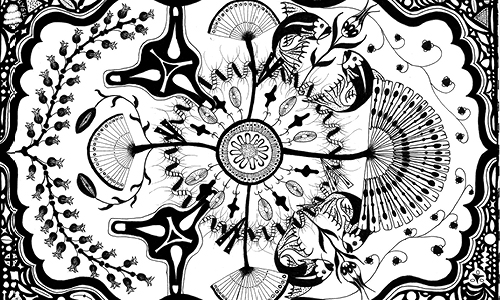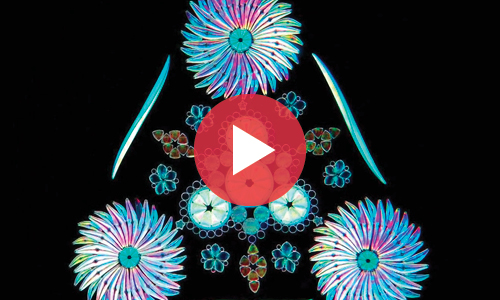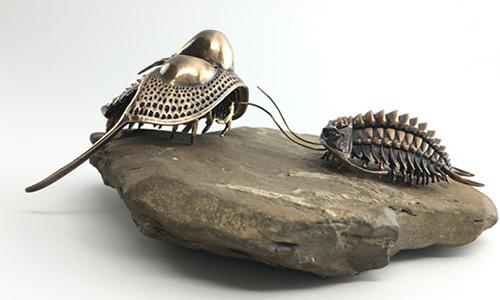|
|
|
|
|
|
| |
|
|
| |
A biologist's art imitates microscopic life. |
|
| |
|
|
|
| |
|
|
| |
|
|
| |
| |
|
|
| |
Diatoms İznik Style is inspired by single-celled algae arranged in a mandala pattern. (Illustration by Duygu Özpolat) |
|
| |
|
|
|
|
| |
|
|
|
| |
|
|
| |
When Duygu Özpolat took the Marine Biological Laboratory embryology course in 2013, she was inspired by all that was contained in a single drop of seawater. Through her microscope, she could visit tiny secret worlds--too beautiful, she thought, to keep to herself. |
|
| |
|
|
|
| |
|
|
| |
Raised in Turkey, Özpolat combined Turkish motifs and styles, such as those found in İznik ceramics, with the microscopic landscapes she saw in the lab. The results were mandala-like ink drawings. |
|
| |
|
|
|
| |
|
|
| |
|
|
| |
| |
|
|
| |
Plankton Tow includes shapes of marine invertebrate larvae that may be found in a plankton tow or ocean dredging. (Illustration by Duygu Özpolat) |
|
| |
|
|
|
|
| |
|
|
|
| |
|
|
| |
Her art, which has been featured in SciArt Magazine, is also influenced by the Victorian-era practice of styling diatoms--unicellular algae with silica cell walls that cluster into geometric shapes. Microscope-owning 19th-century artists would arrange minuscule star-, fan-, and ribbon-shaped diatoms on a slide in symmetrical patterns, which were often sold to amateur naturalists who would exhibit them at parties. |
|
| |
|
|
|
| |
|
|
| |
|
|
| |
| |
|
|
| |
Short documentary film The Diatomist features Klaus Kemp, the last known practitioner of the Victorian art of diatom arrangement. |
|
| |
|
|
|
|
| |
|
|
|
| |
|
|
| |
As an MBL Hibbit Fellow, Özpolat created her own research program (as an alternative to a traditional postdoc experience) studying regeneration in invertebrates and how it could improve human wound and disease treatment. Exploring microscopic worlds is still the most satisfying part of her career. "That just never gets old for me," she says. "I love watching these animals do their thing and seeing it as it happens. Such joy." |
|
| |
|
|
|
|
|
| |
|
|
| |
Six more ways art and science intersect |
|
| |
|
|
|
| |
|
|
| |
|
|
|
| Fermilab's artist in residence pulled parts from old particle accelerators to make physics-inspired installations. |
|
|
|
| |
|
|
|
|
|
|
|
|
|
| |
|
|
| |
|
|
|
| Artists combine what we know about exoplanets with speculation and imagination to draw strange new worlds. |
|
|
|
| |
|
|
|
|
|
| |
|
|
| |
|
|
|
| Use a human-brain-inspired neural network algorithm to create your own art. |
|
|
|
| |
|
|
|
|
|
| |
|
|
| |
|
|
|
| A computational neuroscientist uses C. elegans as a research and art model in this award-winning photo. |
|
|
|
| |
|
|
|
|
|
|
|
|
|
|
|
|
|
| |
|
|
| |
|
|
| |
| |
|
|
| |
(Photo courtesy D. Allan Drummond) |
|
| |
|
|
|
|
| |
|
|
|
| |
|
|
| |
Five hundred million years ago, trilobites--three-lobed segmented arthropods--swarmed the seas, leaving fossils on every continent. But because they are embedded within rock, one half of their bodies remains hidden. As a kid, artist and UChicago biochemist D. Allan Drummond wanted to flip them over to see what was underneath. |
|
| |
|
|
|
| |
|
|
| |
Now he brings trilobites back to life as sculptures you can pick up, roll around, and study from all angles. Drummond designs the trilobites meticulously, using historical and contemporary photos and papers. He then 3-D prints individual pieces, has them cast in bronze using a lost-wax technique, and finally assembles them to resurrect an animal extinct for a quarter billion years. |
|
| |
|
|
|
|
|
|
|
|
|
| |
|
|
| |
Win this mug:
Forward µChicago, and we'll enter you in our monthly drawing.
|
| |
|
|
|
|
|
|
|
|
|
|
| |
|
|
| |
| |
|
|
| |
Good things come to those who share! Forward µChicago to a friend and be entered to win a prize. Congratulations to last month's contest winner, Jeffery Coffer.
Sign up to receive µChicago monthly. |
|
| |
|
|
|
|
| |
|
|
|








